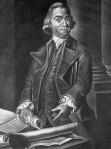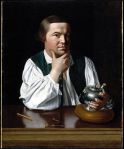By Christopher B. Daly
During the current revelations about the extent of routine surveillance being conducted on American citizens by agencies ranging from the NSA to the Postal Service, it might be worth recalling how this liberty-loving country was founded.
In the 1760s and early 1770s, a growing minority of British colonists living in North America were developing longer and longer lists of grievances against the Crown and Parliament. These Whigs (or patriots) looked for ways to turn their concern into practical action to resist what they considered abuses of their rights as Englishmen.
Recognizing the power of information and coordinated action, they formed Committees of Correspondence — first in Boston and later in all the colonies. They eventually became tantamount to shadow governments, but they
began as a mechanism for sharing information, views, and debates. Immediately, the founders recognized a problem: most of the mail that passed through the British postal system was routinely read by postmasters. So, if the Whigs were going to get organized on a continental basis, they needed to find a way to escape from that surveillance if they were to avoid arrest and punishment.
The answer was the Committees of Correspondence, which developed a shadow post office to serve their needs. When one committee had an important message to send to another, the members dispatched a private post rider, who carried the message on horseback — from Boston to New York, say, or from Baltimore to Savannah. Alternatively, they might dispatch a loyal Whig aboard a ship carrying the printed or handwritten messages on his person.
One famous case in point: after the dumping of the tea into Boston Harbor in December,
1773, the Boston Committee of Correspondence dispatched none other than Paul Revere to carry the news to Manhattan. That was a trip of more than 200 miles by horseback, which Revere completed in less than a week, over pretty rough roads, as winter was settling in. Long before his famous ride to Lexington and Concord, the Boston copper- and silversmith made other, lesser-known but essential rides for the cause.
From the patriot point of view, this system was a clever, heroic, and indispensable work-around that was a vital means for advancing the cause of liberty.
From the British point of view, of course, this was an illegal conspiracy to commit treason.
[Postscript: As soon as the revolution began, the (illegal) Continental Congress began trying to conduct foreign affairs in hopes of drawing other nations into the revolutionary battle against Britain. The Congress set up a “Committee of Secret Correspondence,” led by Benjamin Franklin. Members began reaching out to contacts in Europe, but of course they could not use the British postal system and the new revolutionary government had not established its own. So, they turned to private couriers, who carried the committee’s secret messages. Later, this committee was renamed the Committee for Foreign Affairs. Thanks to the U.S. State Dept Office of the Historian for that one.]



Two comments.
1) Have you read Jack Shafer on partisan journalism? http://blogs.reuters.com/jackshafer/2013/07/16/from-tom-paine-to-glenn-greenwald-we-need-partisan-journalism/
2) I left this reply to one of your book reviewers on Amazon as I’m troubled by the seeming spread of ignorance among the American electorate:
———–
This blatant lie invalidates your entire review in my eyes:
“CBS’s 60 Minutes host Dan Rather and producer Mary Mapes 60 Minutes who used forged documents (2004) about President George W. Bush’s service in the Air National Guard less than two months before the presidential election.”
The only thing that can truly be said about those documents is that their provenance is unknown. It turns out that IBM Selectric typewriters with the font used on those documents were available during the time period in question but this was not discovered until after Dan Rather (along with other journalists and media personalities) was fired for his opposition to the tragically mistaken war in Iraq.
So that “fact” was complete fabrication. How many of your other “facts” are the same? People who watch Fox “News” seem to have trouble with the definition of the word “fact.”
————
LikeLike